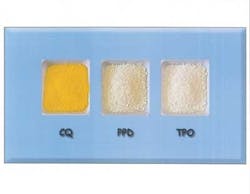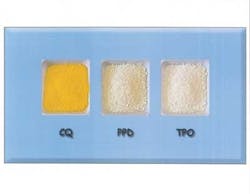See the light?
Gary M. DeWood, DDS, MS
For more on this topic, go to www.dentaleconomics.com and search using the following key words: restorations, light-cured composites, polymerization, Dr. Gary M. DeWood.
Light-cured composites allow dentists to use the same artistry technicians used for decades to create ceramic restorations that mimic nature, but with a material that can be applied and finished in the dental chair. Because composites must undergo polymerization, the goal of light curing is to get the required dosage of energy to every molecule of the initiator.
The original photo-initiator for dental composite was camphorquinone (CQ). It is a yellow material (Fig. 1) that absorbs light between 380 and 510 nm (Fig. 2). In recent years, it has been joined by phenyl-propanedione (PPD) and trimethylbenzoyl-diphenyl-phosphine oxide (TPO).
Absorption Spectrum (Fig. 2)
PPD (Fig. 1) and TPO (Fig. 1) have a color that is better suited to light shades and clear materials since they lack CQ’s yellow signature. But they do absorb light in notably different spectrums than CQ (Fig. 2). This has created some noncuring incompatibility.
Dental curing lights create light energy in one of three ways. The original lights, and many excellent lights available today, use an incandescent quartz-tungsten halogen bulb (QTH). This bulb emits light in almost exactly the same wavelengths that CQ absorbs.
Some dental curing lights use fluorescent design, creating a plasma arc with a slightly less broad emission spectrum that is nonetheless equally effective in polymerization initiation (PAC).
Emisson Spectrum (Fig. 3)
The final type of light used in dentistry is constructed from a semiconductor diode, an LED. LED lights are compact, lightweight, and operate at cooler temperatures than QTH and PAC lights. These features, combined with the fact that they can be designed in cordless versions more easily than the other two types, have made them the most popular choice for the past several years.
LED lights have an emission spectrum between 430 and 510 nm (Fig. 3), excellent for absorption spectra of CQ and PPD — the initiators used in almost all dental composites. A few clear “sealers” and sealants, which use TPO as the only initiator due to its lack of color, will not be polymerized with an LED light. Recently introduced polywave LED lights have an added emission spectrum that will initiate polymerization in these materials as well.
Consider what materials you use in your practice prior to deciding which light is right for you. There are benefits and limitations inherent in all of them.
Having been involved with curing lights since their inception, I have worked with a great number of them — QTH, PAC, LED, and LED polywave lights. My most recent favorites in a completely nonscientific review (I like how they handle and their features) are 3M ESPE’s Elipar S-10 (LED), Kerr’s DemiPlus (LED), DENTSPLY’s SmartLite Max (polywave LED), and Ivoclar’s Bluephase G2 (polywave LED).
Gary M. DeWood, DDS, MS, earned a DDS from Case Western Reserve University in Cleveland, Ohio, and an MS in biomedical sciences from the University of Toledo College of Medicine. He serves as executive vice president for curriculum for Spear Education, teaching and practicing in Scottsdale, Ariz. Contact him at [email protected].

